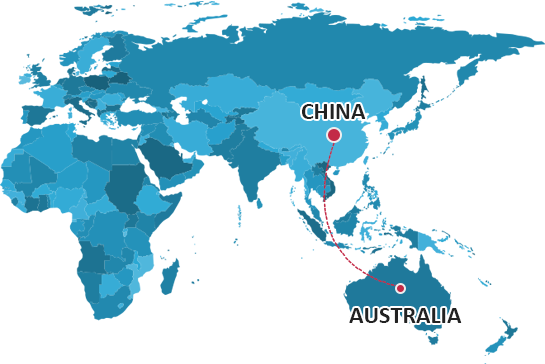China is Australia’s largest export market and its largest source of imports. Overall, it accounts for more than 30% of Australia’s trade. The total bilateral trade between China and Australia in 2022 will be US$220.9 billion, and China’s exports to Australia will be US$78.8 billion. How to Shipping from China to Australia is also what many exporters want to know.This guide will explore various aspects related to freight forwarding from China to Australia.
Freight forwarding from China to Australia
Freight forwarding from China to Australia involves the coordination and management of the transportation of goods between these two countries. It encompasses a range of activities including booking transportation, handling documentation, and ensuring compliance with customs regulations.

What is a freight forwarder?
A freight forwarder is a person who provides services such as handling transportation formalities, picking up, dispatching and transporting goods on behalf of others.
Specifically, in the international freight market, a freight forwarder is between the cargo owner and the carrier. He accepts the cargo owner’s entrustment and handles a series of cargo transportation-related businesses such as chartering, booking, loading, preparing relevant documents, customs declaration, inspection, insurance, container transportation, unpacking, issuing bills of lading, settling freight and miscellaneous charges, and even negotiating and settling bills of lading and foreign exchange according to the instructions of the customer.
Responsibilities of freight forwarders from China to Australia
The responsibilities of freight forwarders in this route are extensive. They include:
- Arranging transportation: Selecting the most appropriate mode of transport based on the nature and urgency of the goods.
- Document management: Ensuring all necessary documents such as bills of lading, customs declarations, and certificates of origin are accurately prepared and submitted.
- Cargo tracking: Keeping the shipper informed about the progress of the shipment at every stage.
- Customs clearance assistance: Navigating the complex customs processes in both China and Australia to ensure smooth passage of goods.
How to Choose the Right Freight Forwarder from China to Australia
When choosing a freight forwarder for this route, several factors need to be considered:
- Experience and expertise: Look for a forwarder with a proven track record in handling shipments between China and Australia.
- Network and partnerships: A strong network of carriers and agents in both countries ensures efficient service.
- Reputation and references: Check for positive reviews and seek references from other businesses.
- Technology and tracking capabilities: Modern tracking systems provide real-time updates on the shipment’s status.
Why choose a Chinese freight forwarder instead of an Australian freight forwarder?
There are several reasons for choosing a Chinese freight forwarder:
- Familiarity with the Chinese market: They have in-depth knowledge of local suppliers and manufacturing hubs.
- Cost-effectiveness: Due to their extensive networks and volume of business in China, they can often negotiate better rates.
- Cultural understanding: Better understanding of business practices and communication styles in China.
Trade between China and Australia
The trade relationship between China and Australia is significant and diverse. It encompasses a wide range of goods including resources, consumer products, and agricultural commodities. The volume of trade continues to grow, highlighting the importance of efficient freight forwarding.
Shipping Methods from China to Australia | Sea freight and Air freight
There are two primary shipping methods available for transporting goods from China to Australia: sea freight and air freight.
Sea freight from China to Australia
Sea freight is the most common and cost-effective option for large volumes of non-urgent goods. It takes longer but offers greater capacity.
Containers of various sizes can be used, depending on the volume of the shipment. The journey by sea can take several weeks, depending on the port of departure and destination in Australia.
Air freight from China to Australia
Air freight is the preferred choice for time-sensitive and high-value goods. It is significantly faster but comes at a higher cost.
Goods are transported on commercial passenger or dedicated cargo aircraft. Air freight can deliver goods within a few days.
Cost Of Shipping 40ft Container From China To Australia
The cost of shipping a 40ft container from China to Australia varies depending on several factors such as the time of year, fuel prices, and the specific ports involved.
On average, it can range from a few thousand to tens of thousands of dollars.

Shipping Container Cost From China To Australia
The overall cost of shipping containers includes not only the transportation cost but also additional charges such as port handling fees, customs duties, and insurance.
It’s essential to obtain detailed quotes from freight forwarders to get an accurate estimate.
How long does it take to ship from China to Australia
The transit time depends on the chosen shipping method.
Sea freight time from China to Australia
Typically, it can take anywhere from 15 to 30 days, but it may be longer depending on port congestion and weather conditions.
Air freight time from China to Australia
Air freight usually takes 3 to 7 days.
Cheapest Shipping from China to Australia
To find the cheapest shipping option, it’s necessary to compare quotes from different freight forwarders and consider factors such as the nature of the goods, transit time requirements, and volume.
Importing goods from China to Australia for customs clearance
Importing goods requires compliance with Australian customs regulations. The freight forwarder plays a crucial role in ensuring all necessary documents and duties are properly handled to avoid delays and penalties.
In conclusion, understanding the intricacies of freight forwarding from China to Australia is essential for businesses engaged in trade between these two countries. By making informed decisions and working with the right freight forwarder, the process can be seamless and cost-effective.



